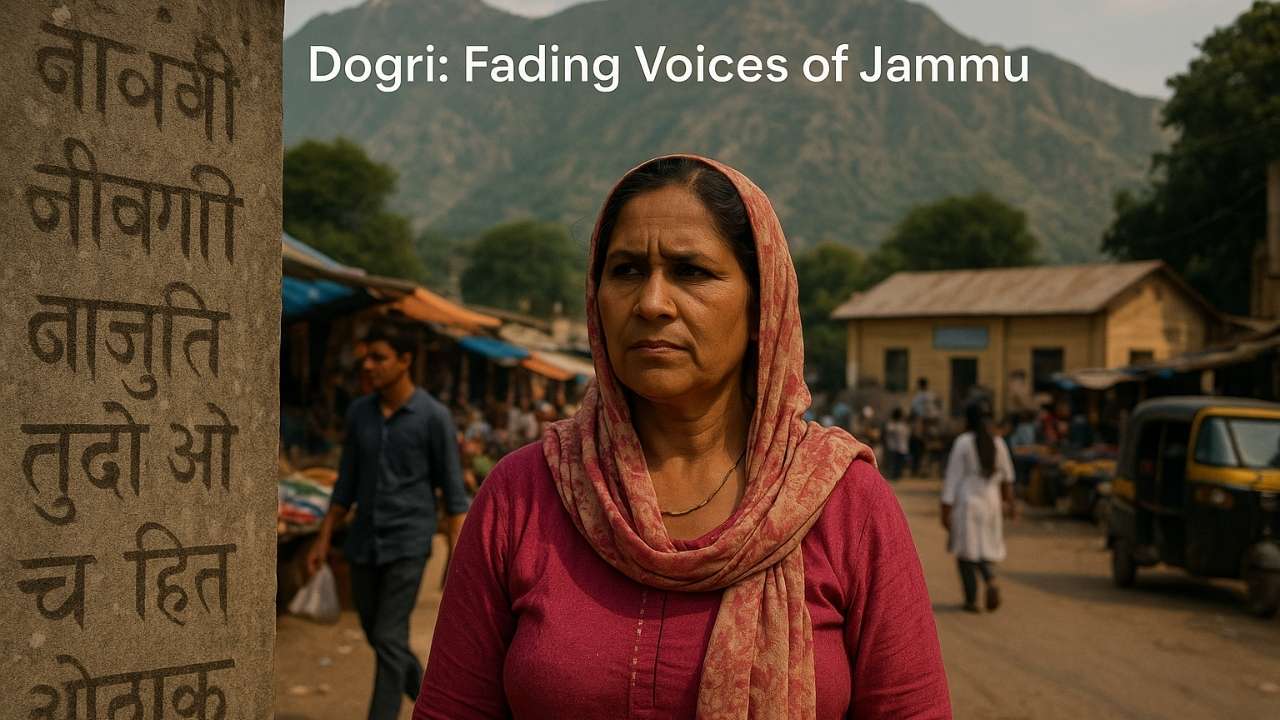Recent surveys have highlighted a sharp decline in the use of Dogri, a regional language of the Jammu region, despite its recognition as an official language of Jammu & Kashmir in 2020. Experts attribute this fall to weak policy support, generational shifts, and growing urban neglect.
Background
- India is home to one of the world’s richest linguistic heritages but also faces rapid language loss.
- According to UNESCO, India has already lost over 220 languages in the past 50 years, with many more endangered.
- In this context, the Dogri language, spoken mainly in the Jammu region, is experiencing a steady decline in daily use and literacy levels.

Current Status of Dogri
- Dogri received constitutional recognition in 2003 and became one of J&K’s five official languages under the Jammu and Kashmir Official Languages Act, 2020.
- However, its official status has not translated into widespread practical use in schools, administration, or employment.
- Globalisation and migration have led speakers, especially the youth, to prioritise Hindi and English for better job opportunities and social mobility.
Lack of Governmental and Institutional Support
- Nearly 48% of surveyed respondents felt that the government has not taken adequate steps to promote or preserve Dogri.
- Delayed recognition has weakened its institutional base — unlike Urdu or Hindi, Dogri lacks presence in school curricula and public offices.
Generational Divide
- Older generations (60+) retain strong speaking and reading skills in Dogri.
- Middle-aged groups (41–60 years) show declining writing proficiency (around 0.25%).
- Younger people (below 20 years) show no reading or writing proficiency, revealing a severe transmission gap.
Rural–Urban Disparity
- Around 56% of rural residents actively speak Dogri; 15% can write it.
- In urban areas, only 45% speak the language and a mere 4% can write it.
- Urban migration and English-medium education have accelerated language shift in towns and cities.
Broader Linguistic Context
- The Dogri case mirrors India’s broader trend of linguistic erosion, where smaller languages lose space to dominant ones.
- English and Hindi are often viewed as languages of progress, causing regional languages to fade from education and homes.
The Way Forward
- Update data: With the 2021 Census pending, updated information on endangered languages is crucial for policy design.
- Revive education: Introduce Dogri in school curricula and local media.
- Change mindset: Promote linguistic pride by recognising regional languages as carriers of culture, not barriers to progress.
- Community participation: Encourage local initiatives to document, teach, and celebrate Dogri through literature and digital platforms.
OFFICIAL LANGUAGES OF INDIA
Constitutional Basis
- Articles 343 to 351 of the Indian Constitution deal with the official language provisions.
- These articles are part of Part XVII of the Constitution (Official Language).
Official Languages
- Hindi (in Devanagari script) is the official language of the Union.
- English is used as an associate official language for official purposes (along with Hindi).
- The use of English was to continue initially for 15 years after 1950 but has been extended indefinitely by the Official Languages Act, 1963.
Regional Languages
- States can choose their own official languages for state-level administration.
- Many states use their regional languages (like Tamil, Telugu, Bengali, Marathi, etc.) as official languages.
Schedule of Languages
- The Eighth Schedule of the Constitution lists 22 languages recognized by the Government of India.
These include:
Assamese, Bengali, Bodo, Dogri, Gujarati, Hindi, Kannada, Kashmiri, Konkani, Maithili, Malayalam, Manipuri, Marathi, Nepali, Odia, Punjabi, Sanskrit, Santali, Sindhi, Tamil, Telugu, Urdu.
Key Provisions
- Article 343: Hindi in Devanagari script is the official language of the Union.
- Article 344: Formation of a commission and committee to promote the spread of Hindi.
- Article 345: States may adopt any language used in the state or Hindi as their official language.
- Article 346–347: Deals with communication between states and with the Union in official languages.
- Article 350: Provides for language used in representations for redress of grievances.
- Article 351: Directs the Union to promote the spread of Hindi and enrich it by assimilating forms and expressions from other Indian languages.
Conclusion
Dogri’s decline is not just a linguistic concern but a cultural warning. Unless the government, educators, and communities act collectively to preserve it, another piece of India’s linguistic diversity may soon be lost to history.
This topic is available in detail on our main website.





